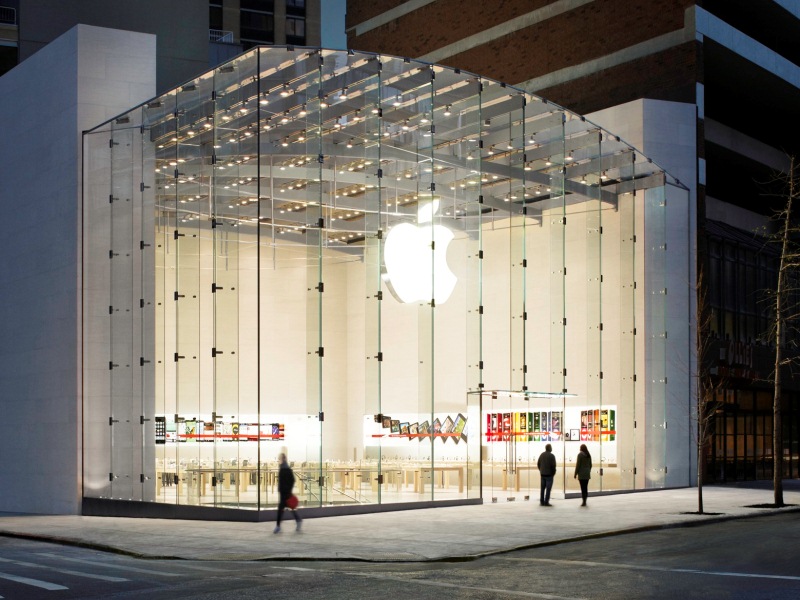Each January, 24/7 Wall St. forecasts the publicly traded U.S. companies that will have the highest profits in the year ahead. This year, Apple almost certainly will keep first place, well ahead of number two Exxon, as the most profitable corporation in America. It already passed the oil giant in market capitalization. However, while the market appears to anticipate continued rapid growth from Apple, its prospects have dimmed somewhat. After reaching all-time highs last year, Apple’s stock advance has stopped and shares have sold off recently.
Click here to see the most profitable companies
The list of most profitable companies is still dominated by oil companies, banks and big tech. A look back at profits over the past five years shows that this trend has continued. Some of these companies have not grown much on the top line of revenue for several years. But they continue to be earnings machines because of their long-time sales success, which will help them produce higher profits in the foreseeable future. Microsoft is the best example of this. The software company is no longer considered a leader in the tech world, a position taken by public corporations like Google. Yet, Microsoft’s Windows and business franchises still have huge profit margins. Microsoft’s net income is greater than that of almost all other tech firms.
24/7 Wall St. used Capital IQ data to identify companies with the largest profits, defined as net income, over the past 12 months. This included revenue and earnings forecasts and pricing data. We then reviewed earnings forecasts for the final quarter of 2012 and for the full year of 2013 to gauge growth prospects for this year. In addition, as part of the process, 24/7 Wall St. looked at the top 1oo companies in the Fortune 500 based on revenue. We again reviewed earnings and earnings forecasts for these based on Cap IQ data. In some cases, earnings appeared to be too low or too high because of events in the past month. We took those into account when we produced the final numbers.
Also Read: The Most Innovative Companies in the World
These are 24/7 Wall St.’s 10 most profitable companies of 2013.
10. Wal-Mart Stores Inc. (NYSE: WMT)
> Forecast 2013 revenue: $467 billion, up 5%
> Forecast 2013 earnings: $16 billion, up 10%
> Stock price: $68.36
> 52-week range: $57.18 – $77.60
> Market cap: $228.68 billion
Walmart employs more than 2 million people, making it the largest company in America by headcount. In the most recent Fortune 500 ranking, Walmart fell just behind Exxon Mobil in total revenue. Walmart is made up primarily of three divisions: Walmart’s domestic stores, its Sam’s Club warehouse operation and Walmart International. Walmart has had a year marked by scandal. Allegedly, executives at the company’s Mexico division bribed government officials. Democratic Congressmen Elijah E. Cummings and Henry A. Waxman recently released information indicating Walmart CEO Mike Duke was aware as early as 2005 of allegations company executives had bribed Mexican government officials.
9. Pfizer Inc. (NYSE: PFE)
> Forecast 2013 revenue: $58 billion, down 1%
> Forecast 2013 earnings: $17 billion, up 6%
> Stock price: $26.76
> 52-week range: $20.75 – $26.77
> Market cap: $197.02 billion
Pfizer’s largest challenge, like that of most other large pharmaceutical companies, is the expiration of patents for much of its drug portfolio. Cheaper, generic versions of these drugs have taken market share. In a recent example, Pfizer had to drop the price of Viagra in Canada to compete with generic versions sold there. Pfizer has gone through a series of layoffs to protect its margins, most recently at its U.S. sales operations. In the latest reported quarter, revenue fell to $14 billion from $16.6 billion in the same period a year ago.
Also Read: The 10 Most Hated Companies in America
8. General Electric Co. (NYSE: GE)
> Forecast 2013 revenue: $148 billion, up 2%
> Forecast 2013 earnings: $18 billion, up 11%
> Stock price: $21.17
> 52-week range: $18.02 – $23.18
> Market cap: $222.00 billion
GE is considered the world’s largest conglomerate. It provides global infrastructure products and services, health care systems, jet engines and transportation services, and household appliances. It also has a large financial services division. One of the major criticisms of GE management is that the company has grown very little over the past several years. Wall St. has reacted negatively, and the stock price has fallen by over a third over the past five years. GE CEO Jeff Immelt is highly visible in business and government circles, and currently heads the U.S. Jobs Council set up by President Obama.
6. (tie) International Business Machines Corp. (NYSE: IBM)
> Forecast 2013 revenue: $107 billion, up 2%
> Forecast 2013 earnings: $19 billion, up 10%
> Stock price: $192.88
> 52-week range: $177.35 – $211.79
> Market cap: $217.94 billion
IBM is one of America’s largest tech companies. It is also one of the most diverse. Its strength in sales to corporations and government has allowed it to largely avoid many of the troubles that have faced firms like Dell Corp. (NASDAQ: DELL) and Hewlett-Packard Co. (NYSE: HPQ), which are more dependent on sales to consumers. IBM has significant operations in Europe and Asia. It sells hardware — including mainframe computers — software and IT services. It also has consulting operations and a finance division. IBM is one of America’s oldest tech companies, and in 2011 celebrated its 100th anniversary of its founding. The company last year appointed its first female CEO — Ginni Rometty.
6. (tie) Wells Fargo & Co. (NYSE: WFC)
> Forecast 2013 revenue: $85 billion, down 1%
> Forecast 2013 earnings: $19 billion, up 9%
> Stock price: $35.40
> Range: $28.77 – $36.60
> Market cap: $186.36 billion
Wells Fargo is one of America’s “big four” commercial banks, alongside Chase, Citigroup Inc. (NYSE: C) and Bank of America Corp. (NYSE: BAC). The company recently reported better-than-expected earnings. The quality of those numbers confirmed what many analysts believe: Wells Fargo has been able to build “a reputation as one of the strongest banks in the country,” as ABC News reported. An indication of Wall St.’s admiration for the bank is that its share price has well outperformed its peers over the past five years. Like the other large American banks, Well Fargo is highly diversified. It has retail bank operations, commercial operations that handle business lending, an investment bank and a wealth management business.
5. J.P. Morgan Chase & Co (NYSE: JPM)
> Forecast 2013 revenue: $100 billion, up 2%
> Forecast 2013 earnings: $20 billion, up 6%
> Stock price: $46.15
> Range: $30.83 – $46.49
> Market cap: $175.44 billion
J.P. Morgan Chase CEO Jamie Dimon was until recently considered the preeminent chief executive in his industry. His name was often mentioned as a possible candidate for Treasury Secretary when Tim Geithner retired. As a matter of fact, Warren Buffett said he favored Dimon for the job. But J.P. Morgan has had its share of trouble recently, and the Treasury job position went to Obama’s chief of staff, Jack Lew. The heart of J.P. Morgan’s trouble was a large trade that cost the bank more than $6 billion. It was made by London investment employee Bruno Iksil, who has been called the “London Whale” because of the magnitude of the hit to J.P. Morgan’s financials. Dimon readily admitted that poor management was the cause of the problem, which cost the bank’s chief investment officer her job and caused Dimon to replace the head of London trading operations. As a result, Dimon could lose most of his bonus for last year.
3. (tie) Microsoft Corp. (NASDAQ: MSFT)
> Forecast 2013 revenue: $80 billion, up 9%
> Forecast 2013 earnings: $24 billion, up 7%
> Stock price: $26.46
> Range: $26.26 – $32.95
> Market cap: $222.70 billion
Microsoft, once the most powerful and largest software company in the world, has fallen on hard times. Its flagship product — Windows — was recently updated. The new operating system, Windows 8, has not done well, partly because global PC sales have slowed considerably. Unfortunately for Microsoft, PC sales are not expected to improve this year, as consumers move to tablets and smartphones. Microsoft has several other challenges. Its Online Services Division, made up of its Bing search engine and MSN portal, has struggled with losses. Google Inc. (NASDAQ: GOOG) remains the dominant search engine by far, which has hurt the chances of growth for Bing. Microsoft has also had trouble gaining adoption of its mobile Windows product, which relies in large part on its partnership with handset giant Nokia Corp. (NYSE: NOK). Microsoft’s struggles have hurt it on Wall St. — its stock is down more than 20% over the past five years.
Also Read: America’s Best (and Worst) Online Retailers
3. (tie) Chevron Corp. (NYSE: CVX)
> Forecast 2013 revenue: $260 billion, up 8%
> Forecast 2013 earnings: Flat at $24 billion
> Stock price: $110.47
> Range: $95.73 – $118.53
> Market cap: $216.21 billion
Chevron is the third largest company in the U.S., based on revenue, according to Fortune, behind only Walmart and Exxon Mobil. Like most of the other large U.S. oil and diversified energy firms, much of Chevron’s revenue comes from overseas. In the most recent quarter, Chevron’s total sales were $55.7 billion, of which $32.4 billion was pegged as “international.” Chevron recently forecast that its financial results for the final quarter of 2012 would be particularly strong. Chevron has significant operations in the natural gas sector, has gas stations under the Chevron, Texaco and Caltex brands, and has large shipping and pipeline operations. Chevron’s stock has outperformed those of most of its global peers over the past five years and has risen 20% over that period.
2. Exxon Mobil Corp. (NYSE: XOM)
> Forecast 2013 revenue: $473 billion, down 1%
> Forecast 2013 earnings: $37 billion, up 2%
> Stock price: $89.10
> Range: $77.13 – $93.67
> Market cap: $406.24 billion
Exxon Mobil is the world’s fourth largest oil company, the largest company in the U.S. based on revenue, and the second largest public corporation in the world based on market capitalization. Like most large energy companies, Exxon has made a large bet on the oil sands business, a relatively new way to produce significant amounts of crude. It also continues to increase its capacity to bring crude from deep-sea locations, and it will invest $14 billion in the Hebron fields off the coast of Newfoundland. As with most of the world’s largest energy companies, Exxon has embraced the clean energy and fuel efficiency movements. The amount Exxon said it will spend to expand its business in the next five years is staggering. In its annual “Outlook for Energy,” the company said it expects to invest $185 billion in energy projects in the period.
Also Read: CEOs to Fire in 2013
1. Apple Inc. (NASDAQ: AAPL)
> Forecast 2013 revenue: $191 billion, up 23%
> Forecast 2013 earnings: $46 billion, up 10%
> Stock price: $523.51
> Range: $418.66 – $705.07
> Market cap: $491.60 billion
Apple is arguably the most widely covered company by the press. More than a year after the death of co-founder and CEO Steve Jobs, Apple’s efforts to maintain its preeminence in the smartphone and tablet PC markets are under constant scrutiny. Apple’s pace of change
has been remarkable. In 2007, when the iPhone was launched, the company was a PC and portable music player company. Now, the iPhone accounts for almost half of Apple’s revenue and two-thirds of its profits. Apple’s lead has been eroded by competition from a broad array of products from other companies, led by the Samsung line of smartphones and Amazon.com Inc.’s (NASDAQ: AMZN) Kindle tablet. Apple’s strength in the app business, in which it has had a mammoth lead, is threatened by apps built for the Google Android mobile operating system. There is a great deal of talk about what Apple will do next to remain ahead of its competition in the broad computer, smartphone, tablet and online app and entertainment businesses. Speculation includes the launch of an Apple TV product and a cheaper version of the iPhone. Nervousness about Apple’s prospects have pushed its shares down by almost 15% over the past six months.
Research by Brian Zajac
Thank you for reading! Have some feedback for us?
Contact the 24/7 Wall St. editorial team.





